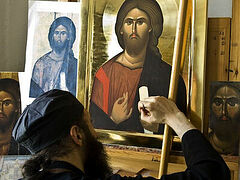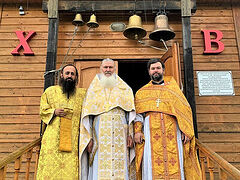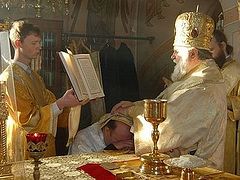 Fr. Siluan Justiniano This is a story of a unique family. Fr. Gregory Justiniano is an islander from Puerto Rico. His three sons are all clergy: two priests and a deacon. For most of his life, Fr. Gregory lived in the United States, then retired and returned to his homeland, where he was destined to start an Orthodox mission, build a temple, and lead a parish for the local people.
Fr. Siluan Justiniano This is a story of a unique family. Fr. Gregory Justiniano is an islander from Puerto Rico. His three sons are all clergy: two priests and a deacon. For most of his life, Fr. Gregory lived in the United States, then retired and returned to his homeland, where he was destined to start an Orthodox mission, build a temple, and lead a parish for the local people.
Today we are speaking with Fr. Gregory’s eldest son—Igumen Silouan (Justiniano) of the Monastery of St. Dionysios the Areopagite in St. James, New York. We were talking with him at the Synod of Bishops in New York City. It was one of the coldest days of this absolutely snowless winter. I walked past the oleander bushes, which are non-exotic for New York. They were green, as in summer, but their leaves were burned by frost and sun.
Fr. Silouan: We lived in a town called San Germán in Puerto Rico. This is the town where my father and most of my family has resettled, and where the Misión Ortodoxa San Juan Clímaco, founded in 2008, is now located. In fact, my entire family started off there. We’re a family of six, with four siblings: my sister Despina, being the firstborn, followed by myself, Fr. Daniel and Fr. Seraphim. My mother’s Christian name is Euphemia, which was also her mother’s name.
My father and grandfather also grew up in San Germán. It is the second oldest city of Puerto Rico, named after St. Germanus of Auxerre, in the southwest of the island. My upbringing was very normal. I spent a lot of time playing in the woods and bushes. In Puerto Rico, we’re fortunate to have passionfruit, one among the many tropical fruits of the island. Sometimes passionfruit bushes grow wild in the garden and create wonderful canopied playgrounds. So, I used to go under the bushes and enjoy the seclusion. I had a great time hiding there, comfortably sheltered, enjoying the dappled beams of light passing through the leaves, and the sweet aroma of the passionfruit, all at once. It was a very nice experience.
 Fr. Gregory Justiniano and his wife
Fr. Gregory Justiniano and his wife
My father was a Protestant, a Pentecostal pastor. Therefore, I grew up within a relatively strict religious environment in Puerto Rico, sheltered from secular culture. I did encounter some aspects of Roman Catholicism, but this remained in the periphery, as a distant cultural phenomenon.
Puerto Rico started off as a Spanish colony, and it therefore still remains primarily Roman Catholic. Hence my father grew up a Roman Catholic and still remembers going to Mass with my grandfather. One of his fondest memories is being dropped off in elementary school by his dad, who had the habit of always blessing him with the sign of the Cross. As a child, Fr. Gregory also caught the last vestiges of priests wearing their cassocks in public, in the old, traditional Roman Catholic style.
In 1898, soon after the Spanish-American War, when Puerto Rico came under United States hegemony, a transition took place. Many Protestant denominations came to the country and became influential. From among these, the Pentecostal movement became very strong in the island. So, as my father grew older, he became estranged from Roman Catholicism and eventually became involved with the Pentecostal movement. I think it was the piety of my grandmother, Euphemia, that impressed him and made him look seriously into Pentecostalism.
 Fr. Gregory and Fr. Siluan Justiniano
Fr. Gregory and Fr. Siluan Justiniano
The Protestant vs. Roman Catholic tension in Puerto Rico is partly incapsulated in one childhood experience. As a five-year old boy, I used to stay with my grandmother in her village in La Pica, a hamlet of the town of Sabana Grande, not too far from San Germán. The villagers were all related, as you could imagine, coexisting in a plot of land they had divided among themselves. Among the villagers was my grandmother’s stepmother, Matilde, who had tons of statues of saints in her dimly lit, cavernous living room. She was Roman Catholic, but many of her relatives in the village were Protestant. The gossip in the village was that she was into Santeria, a form of Voodoo, because of her statues. This didn’t deter my curiosity, so I decided one day to stealthily pay her a visit. Her living room had so many statues and candles that it resembled a little shrine. It made a big impression on me. I was a little scared, but also filled with awe and a sense of the sacred. Perhaps this was my first encounter with a form of sacred art.
 Anyway, eventually my family moved from San Germán to Bayamón, a city in the northeastern coast of the island, near San Juan. We lived there for a few years, since my dad had been hired to the position of director for the Assemblies of God Bible Institute. Assemblies of God was the denomination we were part of for many years, up to our converting to Orthodoxy.
Anyway, eventually my family moved from San Germán to Bayamón, a city in the northeastern coast of the island, near San Juan. We lived there for a few years, since my dad had been hired to the position of director for the Assemblies of God Bible Institute. Assemblies of God was the denomination we were part of for many years, up to our converting to Orthodoxy.
Then in 1985 my family decided to move to the United States. We settled in Danbury, Connecticut, since my father had a cousin and a brother already living there. I was twelve years old, just entering junior high school.
—What was the reason you came to the United States?
—My father wanted to start fresh. He wanted his children to have a good education and more opportunities. When we first came to the US, my father had to start off as a dishwasher in a Mexican restaurant. Eventually he and my mother found jobs at Connecticut Coining Inc., as metal cutters of specialty parts for machines. Then my father proceeded to study at the University of Connecticut, where he obtained a MA degree in ESL bilingual education. Prior to this degree he had obtained a BA in history and education at the Interamerican University of Puerto Rico, San Germán campus. My mother had studied nursing in Puerto Rico, so she went on to obtain a nursing license as a practical nurse, to continue her practice in Connecticut.
After obtaining his degree from UConn, he began his public service work as the director of the Hispanic Cultural Society in Danbury, helping immigrants in town with their various needs.
After that, he worked for the Department of Education in Connecticut as a high school teacher, putting his energies into Bilingual Education.
I studied at Danbury High School, where my father taught, which was a bit of a challenge for me! I had to always look over my shoulder when misbehaving with my friends, just to make sure my dad wasn’t around the corner! The Danbury High School years were pivotal in helping me come to the realization that art, mainly painting, was to become my career path.
If I’m not mistaken, the years 1987–88 mark the beginnings of my interest in art, as a result of meeting two children: Shane and Sotero. They introduced me to the world of graffiti, and that started the ball rolling. Their sketch books blew me away and I really became interested in mastering similar drawing skills. Shane was Mexican and lived on the floor above my family’s apartment. Through him I met Decoy, who was Puerto Rican and older than both of us. Decoy became my mentor, the one who gave me my first drawing and painting lessons. He also introduced me to all kinds of artistic and cultural phenomena. It wasn’t until Decoy took me to the Danbury High School library that I came across and inspected the works of Rafael and Michelangelo, in huge folios packed with color plates. All of this opened my eyes to a completely different world of artistic possibilities.
I took art classes in junior high school and continued them in high school. Upon graduation, I pursued a painting career through studies in the Maryland Institute College of Art in Baltimore. I later transferred to the School of Visual Arts in Manhattan, NY. It was at SVA that I obtained my Bachelor of Fine Arts degree.
—How did your religious background fit into your life as an Arts student?
—As a child, all throughout my life, I remember always hearing about the Lord and the Scriptures. This basically shaped my understating of reality and ethics. But as you grow older you begin to be exposed to the secular culture around you and the worldview of your peers. Hence, I began to feel like I was odd, different from other kids, and so I wanted to be like them, to have the same freedom, to be less restricted by the norms I was taught growing up. This led me to basically reject aspects of my religious upbringing, to rebel against my parents, to experiment in various ways, as is common with teenagers. To tell you the truth, this was the beginning of the process of understanding what it really meant for me to be called a Christian. This process of self-discovery and understanding continued throughout my years in art school.
—Did you believe?
—I guess you could say that I did believe, but I didn’t want to believe! Why? Because believing meant doing what I believed, and I didn’t want to do what was expected of me as a Christian. I didn’t want the difficult path of the Cross!
Nevertheless, I would find myself at college parties arguing with people about things I took for granted, such as the existence of the human soul. Some kids literally denied that there was such a thig as the soul! “How can you deny such a fact?” I would ask them in dismay. “No, you can’t make such an assertion!” I retaliated in astonishment. But how was I to prove my point to a person that only thought of the measurable and quantifiable as the only, true reality? I believed in a higher, spiritual reality, while others were basically crass materialists. It was a clash of fundamental worldview assumptions. It was a rude awakening. I had to confront the fact that if I believed in the existence of the soul, I couldn’t avoid the existence of its maker, the true God. Then, of course, gradually things started to fall into place.
I should also add that existential bitterness also helped in this process! When you are in college you begin to experiment in many ways, with many things, in pursuit of pleasures and exhilarating experiences. But you begin to realize that when you dive deep into your pleasures, it culminates in bitterness. You begin to taste the law of pleasure and pain acutely—pleasure inevitably begets pain. This leads you to ponder, “Okay, I have my freedom away from my parents. I am doing whatever I want without restrictions, but it doesn’t really deliver the fulfilment that I was expecting to derive from it!” Hence a sense of emptiness accompanies the bitterness. In short, you begin to experience the taste of spiritual death. As I started analyzing all these things, I began to understand Solomon’s words, “Vanity of vanities; all is vanity.”
It was around my fourth year of college when I began to reorient my life towards Christ as a Protestant. I had to bite the bullet and finally live according to what I believed. During this time, I began to read more intellectually focused works on the Christian faith, along with critiques on the development of secular philosophy, such as the writings of the famous evangelical theologian and philosopher, Francis Schaeffer. He wrote histories on the development of continental philosophy, analyzing the gradual estrangement in Western civilization, from a Christian worldview to militant secularism. My father was also reading his works.
Ironically, at that time my father bumped into a priest at Danbury High School, who was a substitute teacher, Fr. Timothy Cremeens. My dad asked him what denomination he belonged to, since he couldn’t really pin him down as either Roman Catholic or Protestant. The priest explained to him that he was Orthodox Christian and invited him to visit his parish, St. George Antiochian Orthodox Church on Kohanza Street, Danbury. Providentially, the priest also gave him a newspaper edited by Frank Schaeffer, the son of Francis Schaeffer, the author we were reading.
We looked at the newspaper in amazement and said, “What? The son of Francis Schaffer is Orthodox?” The newspaper was called The Christian Activist. It mainly consisted of Orthodox apologetics, for people coming from a Protestant background. It contained topics we found very interesting, so it introduced us to some aspects of Orthodox theology, tradition and history.
That seemingly random encounter with the priest, and reading the Christian Activist, triggered much curiosity about Orthodoxy in me and my father. Consequently, I proceeded to attend a Sunday Liturgy at the Antiochian parish. My father couldn’t accompany me, since he was still a Pentecostal pastor, taking care of Spanish services for a small Hispanic community, a ministry of the larger English-speaking Assemblies of God church.
Needless to say, the Liturgy had a great impact on me. I couldn’t fully understand intellectually what was happening. I had never seen anything like it, but it left a deep and lasting impression on me, as if I had found what I had been looking for all along. I felt a very real difference between what I had received during the Liturgy, and the Protestant services and Bible studies I was accustomed to. The former felt spiritually nourishing, the later didn’t. I wanted to enter deeper into that inner and palpable mystery that I had experienced in the Orthodox Liturgy.
Consequently, after a few discussions with Fr. Timothy, I became a catechumen. However, by then it was time for me to embark on my graduate studies for painting at Hunter College in New York, so in 1996 I continued my catechism in Manhattan. Later that same year I was received into the Church through the OCA. Attending the OCA was very helpful during this transitional period, since I could understand the services.
As is common, in the early stages of conversion, coming to church gave me a sense of peace and relief from the turmoil of the world. Nevertheless, as you would expect, unforeseen struggles came along and new questions arose. Now that I was Orthodox, how could I better integrate my Faith into my choice of career? I began to experience the tension between the art world I inhabited and the eschatological orientation of life in the Church. Moreover, I still had to deal with my passions. It quickly became apparent that becoming Orthodox didn’t make the spiritual struggle any easier—if anything, it makes you more acutely aware of its intensity. Simultaneously, I was also becoming more familiar with the writings of the Church Fathers, in particular the spirituality of the monastic tradition as incapsulated in the Philokalia. Hence, I began to ask myself whether I should embark on marriage or monasticism as my path towards salvation. Eventually the Lord showed the way, but believe me, it didn’t come easy.
While all of this was unfolding, I was already attending the services at Mercy House, a monastic community (ROCOR at the time) in Manhattan, also known as the Monastery of St. Mary of Egypt. I needed a supportive community, an environment that would constantly remind me of the primary goal of my life as a Christian—deification, union with God. I became a novice in 2001. A few years later, in 2005, I was ordained to the deaconate, and in 2006 to the priesthood.
—What about the rest of your family? Were they already Orthodox at that time?
—I was the first one to be received into the Church in 1996, but later on that same year most of my family became Orthodox. Fr. Daniel took a little longer. He became Orthodox in 2006.
Prior to resigning as a pastor, my father introduced his Pentecostal congregation to Orthodoxy, hoping they would embrace Orthodoxy along with him and our family, but they weren’t ready.
To be continued…







